THE WORLD BIRDS - An Online Bird Book
Order Pelicaniformes
The Pelicaniformes currently contain the pelicans (Pelecanidae), herons (Ardeidae), spoonbills and ibises (Threskiornithidae), Hammerkop (Scopidae), and shoebill (Balaenicipitidae). This order may need to be separated into additional orders as the similarities of these families may be due to convergent evolution and not common ancestors.
Pelecanidae Family - Pelicans And Allies
Order Pelicaniformes
The Pelicaniformes currently contain the pelicans (Pelecanidae), herons (Ardeidae), spoonbills and ibises (Threskiornithidae), Hammerkop (Scopidae), and shoebill (Balaenicipitidae). This order may need to be separated into additional orders as the similarities of these families may be due to convergent evolution and not common ancestors.
Pelecanidae Family - Pelicans And Allies
The pelicans, which belong to the Pelecanidae family, are large waterbirds found worldwide. They primarily inhabit warm regions. The diet of a Pelican consists mainly of fish. They often catch the fish by expanding the throat pouch which must be drained above the surface before they can swallow. They can cool themselves by panting and fluttering their pouch. Pelicans swim well with short, strong legs and feet that have four webbed toes. A layer of special fibers deep in the breast muscles can hold the wings rigidly horizontal for gliding and soaring.
There are eight species of pelicans. Some species catch fish while swimming, while others mainly catch fish by diving from their flights. The males are larger than the females, but they are not differentiated by their plumage. Some species are mainly white, while others are brown or grey. Some species nest on the ground, others in trees. The preference for ground or tree nesting is a function of species size – the larger ones preferring the ground.
Their dimensions range as follow: length 1.25 to 1.9 m (4.1 – 6.2 ft); wingspan 2.0 to 3.4 m ( 6.6 – 11.2 ft); weight 3.6 to 12 kg (7.9 – 26 lb).
Taxonomy
The Pelecanidae family belongs to the Pelecaniformes order which also includes Ardeidae (herons and egrets) and Threskiornithidae (ibises and spoonbills). There are two other families: Balaenicipitidae (shoebill) and Scopidae (hamerkop). Each of these families only contains one species.
Etymology
The name pelican probably traces back to the ancient Greek eleka which referred to woodpeckers. Woodpeckers are notable for their chisel-like bills while pelicans are noted for their supersized bills.
Genus Pelecanus
Pelican,_American White Pelecanus erythrorhynchos
Description: Pure white plumage with black wing tips visible in flight; huge bill with a large pouch below. Breeding: bright orange pouch, orbital skin, feet. Nonbreeding: dull yellowish pouch, orbital skin, feet. Length 1.3–1.8 m (4.3–5.9 ft), wingspan 2.44–2.9 m (8.0–9.5 ft), weight 5–9 kg (22–24 lb).
Distribution: From south-western Canada, through the western United States to Central America and northern South America. Also along the United State Gulf Coast.
Habitat and Behavior: In breeding season nests on islands in fresh water bodies. In winter prefers estuaries or lakes, but may be found on seashores. Avoids open ocean during migration.
Status: Least concern.
Image by: 1) Alan D. Wilson - California 2) Len Blumin - Miller, CA
3, 4) Dick- Ding Darling National Wildlife Refuge, Sanibel Island, Florida Distribution: From south-western Canada, through the western United States to Central America and northern South America. Also along the United State Gulf Coast.
Habitat and Behavior: In breeding season nests on islands in fresh water bodies. In winter prefers estuaries or lakes, but may be found on seashores. Avoids open ocean during migration.
Status: Least concern.

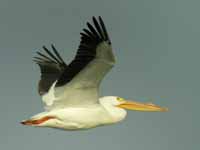


Pelican,_Australian Pelecanus conspicillatus
Description: Mainly white plumage with substantial amount of black on wings. Breeding: orange bill, skin around eyes. Nonbreeding: pink bill, skin around eyes. Juveniles: brown areas instead of black. Length 1.40–1.75 m (4.6–5.7 ft), wingspan 2.45–2.95 m (8.0–9.7 ft), weight 10–11 kg (22–24 lb).
Distribution: Australia, New Guinea, Fiji, parts of Indonesia.
Habitat and Behavior: Found mainly in large expanses of open fresh or salt water without dense aquatic vegetation. Catches fish while swimming. Often works in groups to drive fish to shallower water. Flies in V’s or straight lines.
Status: Least concern.
Image by: 1, 2, 4) Dick Daniels - Australia 3) Paul_BalfeDistribution: Australia, New Guinea, Fiji, parts of Indonesia.
Habitat and Behavior: Found mainly in large expanses of open fresh or salt water without dense aquatic vegetation. Catches fish while swimming. Often works in groups to drive fish to shallower water. Flies in V’s or straight lines.
Status: Least concern.




Pelican,_Brown Pelecanus occidentalis
Description: Grey upperparts; brown underparts; white head with yellow wash. Atlantic subspecies: gray or brown pouch; white nape. Pacific subspecies: olive to red pouch; brown nape. Juvenile: brown head, upperparts; white belly. Smallest of the eight species. Length up to 1.4 m (4.6 ft), wingspan 2–2.3 m (6.6–7.5 ft), weight 3.6–4.5 kg (7.9–9.9 lb).
Distribution: Coastal distribution ranging from North America and the Caribbean to northern South America and the Galapagos.
Habitat and Behavior: Prefers shallow waters, especially near salty bays and beaches; avoids the open sea. Dives for fish.
Subspecies: P. o. californicus – Pacific coast from British Columbia to Guatemala.
P. o. carolinensis – Atlantic coast from New York to Venezuela.
P. o. occidentalis – Caribbean to Venezuela. P. o. murphyi – Columbia, Ecuador, Peru.
P. o. urinator – Galapagos Islands
Status: Least concern.
Image by:
1, 2, 3, 4, 5, 6) Dick Daniels - the Carolinas Distribution: Coastal distribution ranging from North America and the Caribbean to northern South America and the Galapagos.
Habitat and Behavior: Prefers shallow waters, especially near salty bays and beaches; avoids the open sea. Dives for fish.
Subspecies: P. o. californicus – Pacific coast from British Columbia to Guatemala.
P. o. carolinensis – Atlantic coast from New York to Venezuela.
P. o. occidentalis – Caribbean to Venezuela. P. o. murphyi – Columbia, Ecuador, Peru.
P. o. urinator – Galapagos Islands
Status: Least concern.

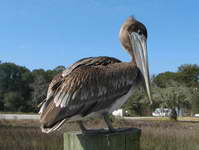



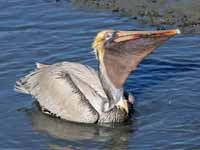
Image by: 1) Sandy Cole - Florida 2) Dick - Half Moon Bay, California 3) Alan D Wilson- La Jolla, California



Image by: 1, 2) Dick - Panama 3) Dick - Galapagos



Pelican,_Dalmatian Pelecanus crispus
Description: Curly nape feathers; grey legs; black wing tips (visible in flight). Breeding: silver-white plumage; orange-red lower mandible, pouch; yellow upper mandible. Nonbreeding: pale brownish-grey plumage; dull yellow bill. Largest member of pelican family. Length 1.60–1.80 m (5.2–5.9 ft), wingspan 2.70–3.20 m (8.9–10.5 ft), weight 10–12 kg (22–26 lb).
Distribution: Found southeastern Europe to India and China.
Habitat and Behavior: Found in lakes, rivers, deltas and estuaries. During winter, usually stays on ice-free lakes in Europe or seasonal lakes in India. Swims or wades for fish. Nests are crude heaps of vegetation, placed on islands or on dense mats of vegetation.
Status: Near threatened.
Image by: 1) Bhardwaj
Shanthanu - India 2) Shizhao - Beijing zoo 3, 4) Dick Daniels - San Diego ZooDistribution: Found southeastern Europe to India and China.
Habitat and Behavior: Found in lakes, rivers, deltas and estuaries. During winter, usually stays on ice-free lakes in Europe or seasonal lakes in India. Swims or wades for fish. Nests are crude heaps of vegetation, placed on islands or on dense mats of vegetation.
Status: Near threatened.
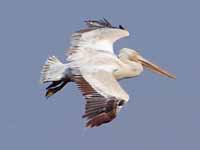
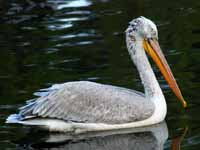
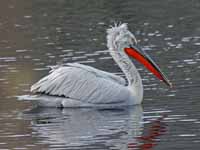

Pelican,_Great White also White Pelican also Rosy Pelican Pelecanus onocrotalus
Description: White plumage with black wing tips visible in flight; pink facial patch, legs; huge pink and yellow bill; pale yellow pouch. Length 1.40–1.75 m (4.6–5.7 ft), wingspan 2.45–2.95 m (8.0–9.7 ft), weight 10–11 kg (22–24 lb).
Distribution: Eastern Mediterranean east to Indochina and Malay Peninsula, and south to South Africa.
Habitat and Behavior: Mainly around fresh water, especially shallow areas such as lagoons and marshes. Nests on the ground. Swims or wades for fish.
Status: Least concern.
Similar to: American White Pelican. Ranges do not overlap. Great White Pelican is larger.
Similar to: Dalmation Plelican. On average, the Dalmation Pelican is larger than the Great White Pelican. Dalmation has a messy hairdo compared with Great White. Dalmation is off white versus pure white for the Great White.
Similar to: Pink-backed Pelican. Great White Pelican is much larger. Pink-backed Pelican is gray versus pure white for the Great White.
Image by: 1) Dick Daniels - De Hoop, South AFrica 2, 3 Dick - Nepal 4) Dick -Kenya Distribution: Eastern Mediterranean east to Indochina and Malay Peninsula, and south to South Africa.
Habitat and Behavior: Mainly around fresh water, especially shallow areas such as lagoons and marshes. Nests on the ground. Swims or wades for fish.
Status: Least concern.
Similar to: American White Pelican. Ranges do not overlap. Great White Pelican is larger.
Similar to: Dalmation Plelican. On average, the Dalmation Pelican is larger than the Great White Pelican. Dalmation has a messy hairdo compared with Great White. Dalmation is off white versus pure white for the Great White.
Similar to: Pink-backed Pelican. Great White Pelican is much larger. Pink-backed Pelican is gray versus pure white for the Great White.




Pelican,_Peruvian Pelecanus thagus
Description: Grey-brown upperparts; brown underparts; white head; white neck (brown nape with vertical white stripe when breeding). Juvenile: brown head, upperparts; white belly. Length up to 1.52 m (5.0 ft), wingspan 2.48 m (8.1 ft), average weight 7 kg (15 lb).
Distribution: West coast of South America, from central Chile to northern Peru.
Habitat and Behavior: Prefers shallow waters, especially near salty bays and beaches; avoids open sea. Dives for fish.
Status: Near threatened.
Similar to: Brown Pelican. Brown Pelican is considerably smaller than Peruvian Pelican. Adult Brown Pelican head is often yellowish; adult Peruvian Pelcian head is white. Peruvian Pelican not found in North America.
Image by: 1) Charlie Westerinen 2) Alastair Rae 3) Manuel Franco 4) Dick Daniels - Papudo. ChileDistribution: West coast of South America, from central Chile to northern Peru.
Habitat and Behavior: Prefers shallow waters, especially near salty bays and beaches; avoids open sea. Dives for fish.
Status: Near threatened.
Similar to: Brown Pelican. Brown Pelican is considerably smaller than Peruvian Pelican. Adult Brown Pelican head is often yellowish; adult Peruvian Pelcian head is white. Peruvian Pelican not found in North America.
1) Juvenile




Pelican,_Pink-backed Pelecanus rufescens
Description: Grey and white plumage; pinkish hue on the back occasionally apparent; yellow upper mandible; grey pouch. Breeding: long plumes on the head. Length 1.27–1.52 m (4.2–5.0 ft), wingspan 2.5 m (8.2 ft), weight c. 5 kg (11 lb).
Distribution: Africa, southern Arabia, and southern India.
Habitat and Behavior: Found mainly on lakes, swamps, slow moving rivers. Occasionally found on sheltered
coasts. Swims or wades for fish, usually in groups. Mainly roosts and nests in trees, but will also roost on ground.
Status: Least concern.
Similar to: Great White Pelican. Great White Pelican is much larger. Pink-backed Pelican is gray versus pure white for the Great White.
Image by: 1) Dick - Jacksonville Zoo, Florida 2, 3, 4) Dick - Fish Eagle Lodge, Knysna Lagoon, KenyaDistribution: Africa, southern Arabia, and southern India.
Habitat and Behavior: Found mainly on lakes, swamps, slow moving rivers. Occasionally found on sheltered
coasts. Swims or wades for fish, usually in groups. Mainly roosts and nests in trees, but will also roost on ground.
Status: Least concern.
Similar to: Great White Pelican. Great White Pelican is much larger. Pink-backed Pelican is gray versus pure white for the Great White.



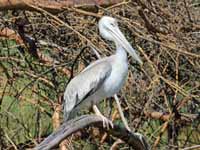
Pelican,_Spot-billed also Gray Pelican Pelecanus philippensis
Description: Plumage mainly greyish-white; grey crest, nape; spots on upper mandible of its bill; pink orbital patch; brownish tail; pink to purplish pouch with large pale spots. Length 1.27–1.52 m (4.2–5.0 ft), wingspan 2.5 m (8.2 ft), weight c. 5 kg (11 lb)
Distribution: Southern Asia. Breeds in peninsular India, Sri Lanka and in Cambodia.
Habitat and Behavior: Shallow fresh water areas. Nests in colonies choosing low trees near wetlands. Swims or wades for fish.
Status: Least concern.
Similar to: Great White Pelican. Spot-billed Pelican is grayish-white versus pure white for the Great White. Spot-billed Pelican has spots on bill.
Image by: 1, 2) Lip Kee - Sri Lanka 3) JM Garg - India 4) Vijay IsmavelDistribution: Southern Asia. Breeds in peninsular India, Sri Lanka and in Cambodia.
Habitat and Behavior: Shallow fresh water areas. Nests in colonies choosing low trees near wetlands. Swims or wades for fish.
Status: Least concern.
Similar to: Great White Pelican. Spot-billed Pelican is grayish-white versus pure white for the Great White. Spot-billed Pelican has spots on bill.
1) Juvenile

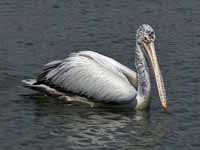


Family Scopidae - 1 genus
It is a matter of debate whether the Hammerkop belongs in the same order as Pelicans or the Storks.
Genus Scopus - 1 species
Hamerkop Scopus umbretta
Description: Mainly blue-gray plumage, huge bill which is straw colored, stock-like dark legs with large feet. Height 110 to 140 cm (43 – 55 in), length 100 to 140 cm (39 – 55 in), wingspan 230 to 260 cm (7 ft 7 in – 8 ft 6 in), weight 4 to 7 kg (8.8 – 15.4 lb).
Distribution: Central tropical Africa from Sudan to Zambia..
Habitat and Behavior: Freshwater swamps and sometimes deeper water with floating vegetation. Tend to move slowly and often stand still. Catches prey by a rapid thrust of its bill. Eats mainly fish, sometimes frogs and snakes. Wary of humans.
Status: Vulnerable.
Image: 1) Dick Daniels - Tanzania 2)
Dick -
San Diego Zoo 3) Sandy - National Aviary 4) Dick - Nairobi National Park, KenyaDistribution: Central tropical Africa from Sudan to Zambia..
Habitat and Behavior: Freshwater swamps and sometimes deeper water with floating vegetation. Tend to move slowly and often stand still. Catches prey by a rapid thrust of its bill. Eats mainly fish, sometimes frogs and snakes. Wary of humans.
Status: Vulnerable.
6) Hammerkop nest, perhaps the world's largest nest 9) Hamerkop warning about presence of lion


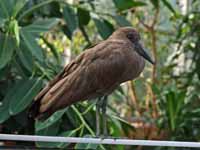

Family Balaenicipitidae - 1 genus
It is a matter of debate whether the Shoebill belongs in the same order as Pelicans or the Storks.
Genus Balaeniceps - 1 species
Shoebill Balaeniceps rex
Description: Medium sized waterbird with brown plumage; long flat blackish bill; (brown for juveniles), partially webbed feet. Height 56 cm (22 in), weight 470 gm (17 oz), bill length 80 to 85 mm (3.1–3.3 in).
Distribution: Sub-saharan Africa, Madagascar, and coastal south-west Arabia.
Habitat and Behavior: Requires shallow water for foraging. Found in all wetland habitats, including rivers, streams, seasonal pools, estuaries, reservoirs, marshes, mangroves, irrigated land such as rice paddies, savannahs, and forests. Catches prey while wading or from surface of water while in flight. Eats mainly fish and amphibians, also shrimp, insects, rodents. Dominant birds may signal to subordinates by opening their bills slightly and erecting their crests. Builds a huge domed nest, sometimes more than 1.5 m (4 ft 11 in) across, and strong enough to support a person’s weight.
Status: Least Concern.
Image by: 1) Darren Bellerby - Jurong Bird Park, Singapore
2) Charlie Westerinen - Prague Zoo 3) Fritz Geller-Grimm -Zoological
Garden, Frankfurt/Main, GermanyDistribution: Sub-saharan Africa, Madagascar, and coastal south-west Arabia.
Habitat and Behavior: Requires shallow water for foraging. Found in all wetland habitats, including rivers, streams, seasonal pools, estuaries, reservoirs, marshes, mangroves, irrigated land such as rice paddies, savannahs, and forests. Catches prey while wading or from surface of water while in flight. Eats mainly fish and amphibians, also shrimp, insects, rodents. Dominant birds may signal to subordinates by opening their bills slightly and erecting their crests. Builds a huge domed nest, sometimes more than 1.5 m (4 ft 11 in) across, and strong enough to support a person’s weight.
Status: Least Concern.


